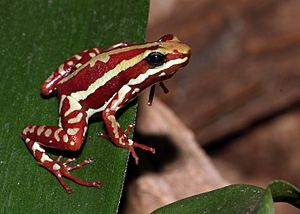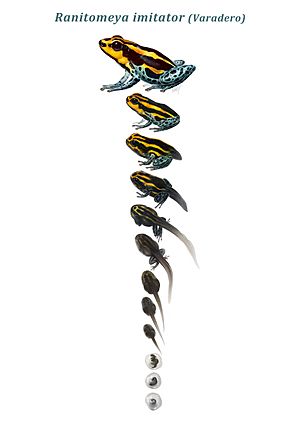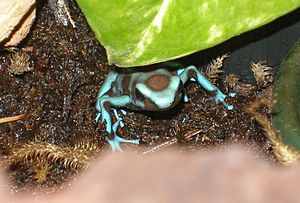Poison dart frog facts for kids
Quick facts for kids Poison dart frogs (Dendrobatidae) |
|
|---|---|
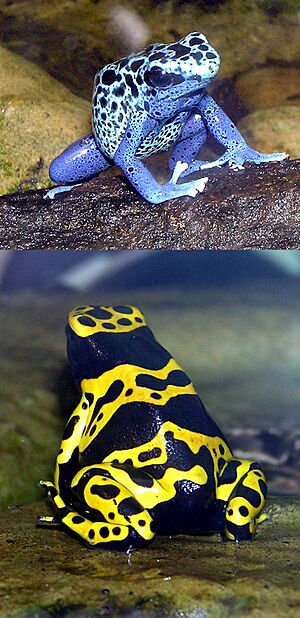 |
|
| Dendrobates tinctorius "azureus" (top) and Dendrobates leucomelas (bottom). | |
| Scientific classification |
|
| Kingdom: | Animalia |
| Phylum: | Chordata |
| Class: | Amphibia |
| Order: | Anura |
| Clade: | Hyloidea |
| Superfamily: | Dendrobatoidea |
| Family: | Dendrobatidae Cope, 1865 |
| Subfamilies and genera | |
|
|
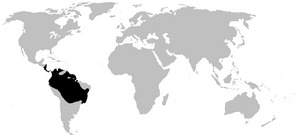 |
|
| Distribution of Dendrobatidae (in black) | |
Poison dart frogs are a special group of frogs. They belong to the family Dendrobatidae. These frogs live in the warm, wet forests of Central and South America.
Unlike most frogs, which are active at night, poison dart frogs are busy during the day. Many of them have super bright colors. These colors act as a warning sign to other animals. They tell predators, "Stay away! I'm poisonous!"
Some species of these amazing frogs are now critically endangered. This means they are at high risk of disappearing forever. Blue poison dart frogs get their poison from the ants and other tiny insects they eat. If an animal tries to eat one of these frogs, it will get very sick.
Contents
Frog Families: Taxonomy
Scientists are always studying dart frogs, so their family tree (called taxonomy) often changes. The Dendrobatidae family currently has 16 different groups, called genera, and about 200 species. Some well-known groups include Dendrobates (the classic poison dart frogs) and Phyllobates (which includes the golden poison frog).
Colorful Frogs: Colour Morphs
Some poison dart frog species have many different color patterns. These are called color morphs. They have developed over thousands of years. For example, the strawberry poison-dart frog (Oophaga pumilio) has many different colors. These colors might have changed because of predators or because frogs choose mates based on their colors.
Frog Features: Characteristics
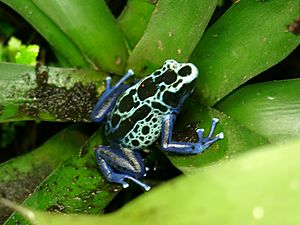
Most poison dart frogs are quite small. Some are less than 1.5 centimeters (0.6 inches) long when they are adults. A few can grow up to 6 centimeters (2.4 inches). On average, they weigh about 1 ounce (28 grams).
Many poison dart frogs are brightly colored. These bright colors are a form of aposematism. It's like a billboard saying, "I taste bad!" The brighter the color, the more toxic the frog usually is. For example, Dendrobates frogs have lots of toxins. But Colostethus species are duller in color and are not toxic.
Poison dart frogs are a great example of an aposematic animal. Their bright colors tell predators they are not good to eat. Scientists think this warning system developed at least four times in the poison dart frog family.
Adult frogs lay their eggs in wet places. This could be on leaves, inside plants, or among roots. Once the eggs hatch, the adult frog carries the tiny tadpoles, one by one, to a safe water spot. This might be a small pool or the water collected in plants like bromeliads. The tadpoles stay there until they change into frogs. The mother frog even feeds them by laying unfertilized eggs for them to eat!
Where They Live: Habitat
Poison dart frogs live only in humid, tropical areas of Central and South America. You can usually find them in tropical rainforests. Countries where they live include Bolivia, Costa Rica, Brazil, Colombia, Ecuador, Venezuela, Suriname, French Guiana, Peru, Panama, Guyana, and Nicaragua. They have also been introduced to Hawaii.
Their natural homes include wet lowland forests, high-altitude shrublands, and areas near rivers and marshes. Some species can also live in places like wet grasslands, farms, gardens, and even heavily damaged forests. They usually live on or near the ground, but some can climb trees up to 10 meters (33 feet) high.
How They Grow: Reproduction
Many poison dart frog species are very caring parents. Some carry their newly hatched tadpoles high into the rainforest trees. The tadpoles stick to the sticky mucus on their parents' backs. Once in the treetops, the parents place their young in small pools of water that collect in plants like epiphytic bromeliads.
The tadpoles eat tiny bugs in their nursery pool. Their mother even adds to their diet by laying unfertilized eggs for them. Other poison frogs lay their eggs on the forest floor, hidden under fallen leaves.
Female frogs usually get to choose their mate. Male frogs often show off brighter colors, protect their territory, and act aggressive towards other males. Females pick their mates based on their colors, where they call from, and their territory.
Frog Poison: Toxicity and Medicine
Many poison dart frogs have special glands in their skin that release alkaloid toxins. These toxins are a chemical defense that protects them from predators. This is why they can be active during the day when predators are around. Scientists have found about 28 different types of these alkaloids in poison frogs.
The most toxic poison dart frog is the Phyllobates terribilis. It's believed that these frogs don't make their own poisons. Instead, they get the chemicals from the insects they eat, like ants, centipedes, and mites. This is called the diet-toxicity hypothesis. Because of this, frogs raised in captivity don't have much poison. But if they start eating a diet with the right insects, they can become toxic again.
Most wild species are not deadly to their predators. They just taste so bad that predators quickly let them go. Even with their strong poisons, some animals, like the snake Leimadophis epinephelus, have become immune to the toxins.
Scientists have also found chemicals from the skin of the Epipedobates tricolor that might be useful as medicine. One chemical, called epibatidine, is a painkiller. However, the amount needed to relieve pain is very close to the amount that could be deadly. Other chemicals from these frogs are being studied as muscle relaxants, heart stimulants, and appetite suppressants. The golden poison frog (Phyllobates terribilis) has enough poison to kill ten to twenty men or about ten thousand mice! Most other poison dart frogs, while colorful and toxic enough to scare off predators, are much less dangerous to humans.
Keeping Them as Pets: Captive Care
All poison dart frogs come from the Neotropics. If you get a frog caught in the wild, it might still have some poison for a while. So, you need to be careful when handling them.
In the wild, poison dart frogs usually live for one to three years. But when they are kept as pets, they can live much longer, sometimes up to 25 years! Many of the larger species take a year or more to become adults. Phyllobates species can take over two years. When kept as pets, most species do best when the air is very humid (80% to 100%). The temperature should be around 22 to 27°C (72 to 80°F) during the day and not lower than 16 to 18°C (60 to 65°F) at night. Some species can handle cooler temperatures better than others.
Protecting Them: Conservation Status
Many poison dart frog species have recently faced big problems. Their homes are being destroyed, they are getting sick from chytrid diseases, and too many are being collected for the pet trade. Because of this, some are now listed as threatened or endangered. Zoos are trying to help by treating sick frogs with a special medicine, similar to what's used for athlete's foot in humans.
Images for kids
-
The skin of the phantasmal poison frog contains epibatidine.
See also
 In Spanish: Ranas punta de flecha para niños
In Spanish: Ranas punta de flecha para niños


